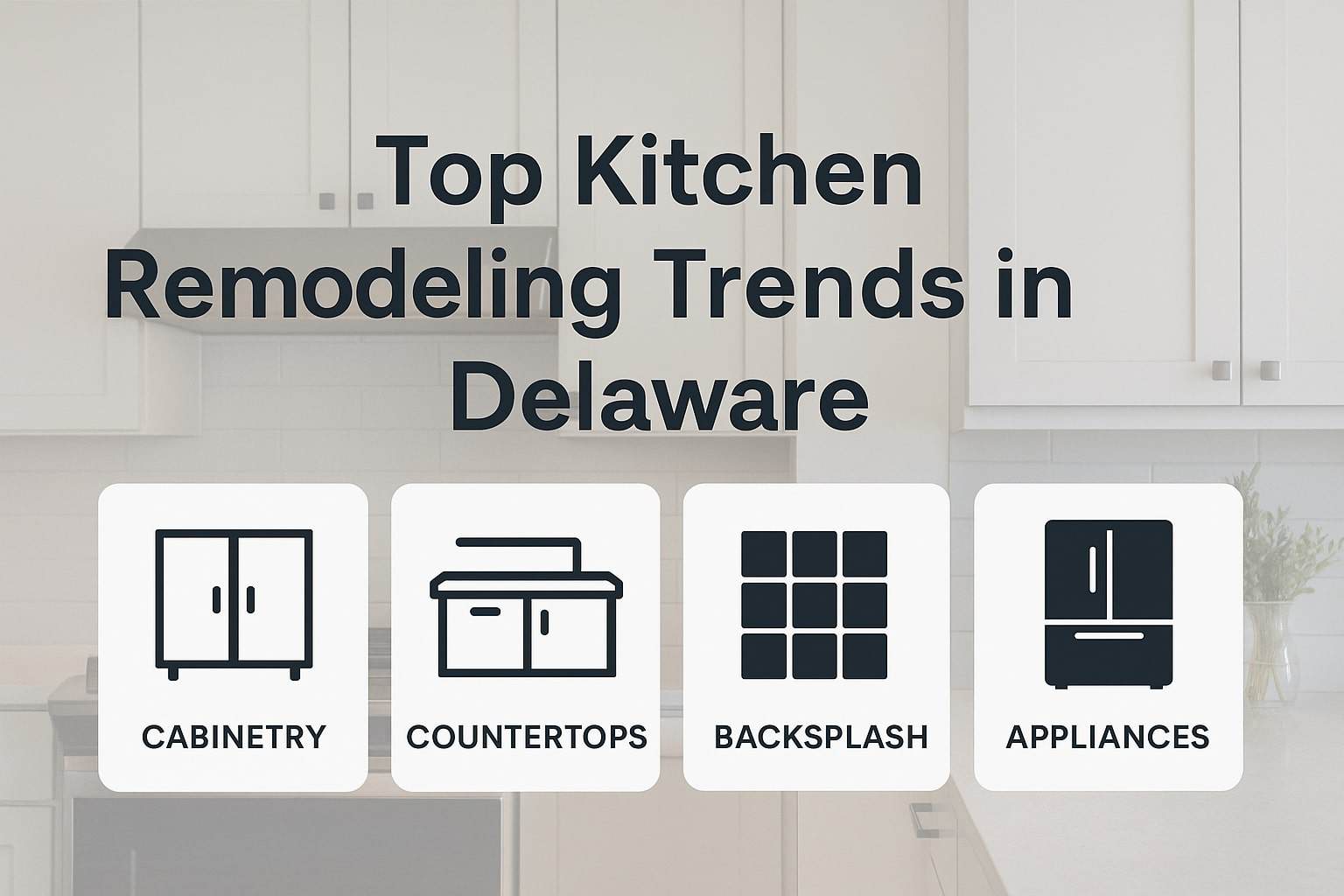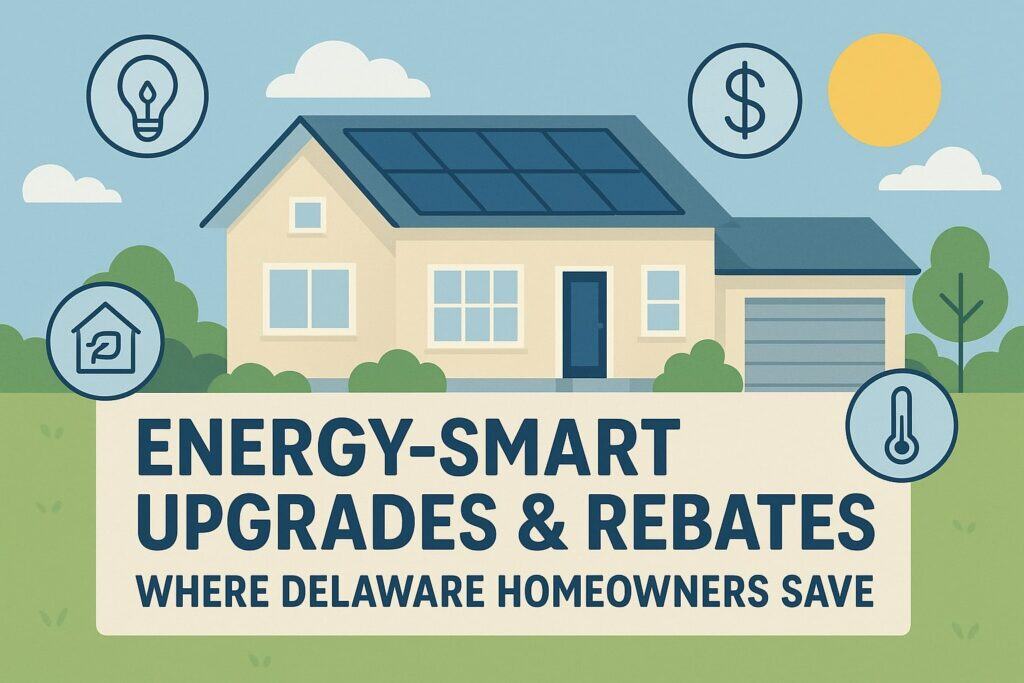
By 302renovations November 4, 2025
Delaware homeowners are reimagining the heart of the home with a mix of coastal-savvy durability, energy-smart upgrades, and warm, timeless aesthetics.
Whether you live in a Wilmington rowhome, a historic Lewes cottage, or a new building near Rehoboth Bay, kitchen remodeling in Delaware now blends climate-ready materials, local permitting know-how, and design trends that will still look fresh in five years.
This guide distills the latest local rules, incentives, materials, and looks—so you can plan a project that’s beautiful, compliant, and built for Delaware’s humidity, salt-air, and four-season living.
Where it matters, we cite Delaware-specific sources on permits, historic review, and rebates to keep you confidently on track.
1) Permits & Codes: The First “Trend” Is Getting The Delaware Paperwork Right

Before you pick a slab or a cabinet pull, the most important step in kitchen remodeling in Delaware is understanding local permits.
In New Castle County, the county clarifies that cosmetic work like cabinet refacing, tile, paint, or countertop swap-outs generally does not require a building permit, but moving walls, relocating plumbing, or altering windows/doors does.
Electrical work is governed at the state level; even if your remodel is “cosmetic,” you may still need a Delaware electrical permit or inspection. Start by mapping your scope: any relocation of outlets, GFCIs, lighting circuits, or appliance feeds likely triggers electrical permitting and inspection.
Sussex County and Kent County administer their own processes and adopted codes. Sussex emphasizes that all construction—including remodeling and additions—requires a county permit (with some program nuances), while Kent County publishes which projects need permits and which state codes they follow.
If your property sits in an incorporated municipality (e.g., Rehoboth, Lewes, Georgetown), the local authority may have additional forms, inspections, or impact fees. This is why Delaware remodels benefit from an early 20–30 minute call to the county building office.
Electrical work has its own lane: the Delaware Board of Electrical Examiners explains homeowner permits, timelines (permits valid one year), and when “replacement in kind” doesn’t need a permit.
If you’ll DIY some electrical, expect state inspectors and specific plan review requirements; many homeowners ultimately choose a Delaware-licensed master electrician to avoid delays.
2) Historic Districts & Coastal Constraints: Designing With Delaware’s Context
A unique feature of kitchen remodeling in Delaware is the number of homes that are either within historic districts or in coastal environments with high humidity and salt exposure.
In Wilmington, the Design Review and Preservation Commission (DRPC) evaluates exterior work affecting historic properties to ensure changes respect historic character—kitchen remodels often involve vent penetrations, window changes, or additions that may require DRPC review.
Along the coast, Lewes has an Architectural Review Commission (HPARC) that provides oversight inside its historic zones. If your remodel touches exteriors—like enlarging a kitchen with a bay window—loop in these boards early.
Climate matters too. Along Delaware’s shoreline, salt air and humidity attack finishes and substrates. Cabinet boxes with moisture-resistant cores (e.g., marine-grade plywood, HMR/MR MDF for specific use cases), sealed edges, and factory-cured finishes survive far better than unsealed particle boards.
Designers who work in coastal zones recommend humidity control, durable finishes, and joinery that withstands expansion/contraction. Your product spec should call out moisture resistance explicitly; it’s a durability “trend” born from the environment, not just style.
Ventilation and indoor air quality deserve special attention, especially in homes with tight envelopes and salt-laden moisture. Good practice includes a range hood that vents outdoors (sized for your cooktop BTUs), make-up air provisions on powerful hoods, and a dehumidification strategy.
Mold risk is higher in coastal settings where micro-cracks and salt corrosion can degrade sealants—design with sealed penetrations and plan for continuous moisture management.
3) Energy-Smart Upgrades & Rebates: Where Delaware Homeowners Save

Energy efficiency isn’t just green—it’s a top trend in kitchen remodeling in Delaware because of escalating utility costs and local incentives. Start with Energize Delaware (the state’s Sustainable Energy Utility), which runs Home Performance with ENERGY STAR® assessments, rebates for efficiency improvements, and low-interest loans.
The program periodically expands and streamlines offerings, including opening certain checkups to broader income tiers.
If your kitchen remodel includes air sealing around new penetrations, lighting, or appliance changes, pairing it with a whole-home assessment can unlock rebates and a prioritized upgrade plan.
Delmarva Power’s Energy Wise Rewards™—available to Delaware and Maryland customers—offers bill credits for demand-response participation. While not a kitchen-specific rebate, it dovetails with smart thermostats, high-efficiency HVAC supporting the kitchen’s comfort, and load management for large appliances.
For new homes or deep retrofits, Delmarva’s ENERGY STAR® New Homes program supports builders/raters in Delaware and can hint at standards homeowners should ask remodelers to emulate.
Keep an eye, too, on the Delaware Energy Office’s announcements for IRA home energy rebates timing (Home Efficiency & Home Electrification/Appliance rebates) as they roll out.
Practical roadmap: schedule an Energize Delaware assessment early; confirm current rebate amounts and eligibility; then align kitchen plans (LED lighting, ENERGY STAR appliances, induction ranges, heat pump water heaters if nearby) with the rebate matrix.
It’s common for homeowners to stack a design-driven kitchen with a rebate-driven envelope/equipment plan and finance the package with low-interest SEU loans.
4) Countertops & Backsplashes: Quartz, Quartzite, Porcelain—and Statement Slabs
The star materials in kitchen remodeling in Delaware this year are durable, low-maintenance, and subtly warm. Quartz remains the most specified countertop surface nationally (and will keep trending into 2026), appreciated for uniformity and stain resistance.
Natural quartzite, prized for heat resistance and unique veining, also grows in popularity; just plan on periodic sealing. Porcelain slabs—thin, heat-tolerant, UV-stable—are surging for both countertops and full-height slab backsplashes, giving coastal kitchens a grout-free, easy-clean surface.
Designers are leaning into warm hues and specialty colors in quartz lines—think creamy off-whites, honey beige, and stones with coppery veining. Slab backsplashes—one continuous sheet behind the range and along work walls—are dominating inspiration feeds for their sleek look and effortless wipe-down, a boon in busy households.
Even celebrity kitchens are showcasing the monolithic “single slab” aesthetic, which you can achieve by matching the backsplash to the counter for a cohesive, upscale look.
If you crave drama, select stones like burgundy or deep, earth-toned marbles in limited zones, or emulate the tone via accessories for a budget-friendly nod to the trend.
Pro tip for Delaware: in coastal homes, verify the resin temperature tolerance and UV performance of engineered stones near large windows, and consider porcelain for sun-soaked spaces.
For historic homes where visible modern slabs may clash with original character, integrate a furniture-style island with stone top while keeping perimeter surfaces quieter—historic review boards tend to favor restraint in publicly visible changes.
5) Cabinets & Finishes: Moisture-Smart Boxes, Coastal-Tough Coatings, Warm Woods
Cabinetry in kitchen remodeling in Delaware is pivoting to construction that defends against humidity swings. For box construction, many Delaware designers specify plywood (often preferred for screw-holding and moisture resistance) or HMR/MR MDF for painted doors and panels that get factory-cured coatings.
Edge sealing, back panel design, and elevated toe-kicks all help in coastal or flood-prone zones. Inside, consider ventilated sink bases, drip trays under plumbing, and sealed cutouts around disposals and water filters.
Finishes are warming up: white remains classic, but soft putty, mushroom, sand, and natural white oak or rift-cut oak bring cozy sophistication that suits Delaware’s blend of traditional and coastal architecture. Hardware trends include aged brass, burnished nickel, and matte black—finishes that hide fingerprints and feel grounded.
In historic homes, inset doors and beaded frames can nod to period millwork while hidden soft-close hardware delivers modern function. For beach houses, favor catalyzed conversion varnish or similar industrial coatings that better resist salt-air and cleaning chemicals.
6) Flooring, Walls & Ceilings: Durable Underfoot, Slab-Style Backsplashes, Quiet Ceilings
Flooring choices in kitchen remodeling in Delaware must handle sand, moisture, and traffic. Large-format porcelain tile remains a coastal champion for dimensional stability and easy maintenance.
In non-flood zones, engineered wood (with a thicker wear layer) offers warmth while tolerating seasonal expansion better than solid wood. If you prefer resilient surfaces, premium LVP with rigid cores and high-quality wear layers can deliver wood looks with superior water resistance—look for products with thick wear layers and credible warranties.
Walls are migrating to slab backsplashes and micro-textured paints in low-sheen finishes for cleanability. If you tile, select epoxy grout for stain resistance.
Ceilings play a bigger role in acoustics and lighting—coffered or beam details hide in-ceiling linear lights, speakers, and ventilation while bringing character that fits Delaware’s historic and coastal homes. Tie all three planes (floor/wall/ceiling) together with a soft, coastal-neutral palette to keep small kitchens airy.
7) Appliances & Cooking: Induction, Steam, and Venting That Actually Works
On the performance front, kitchen remodeling in Delaware is embracing induction ranges for precise, fast, and efficient cooking—an especially good match where makeup air for giant gas hoods is impractical.
Pair induction with a properly sized external-vented hood (capture area matters more than just CFM), and include make-up air if you exceed code thresholds. Steam ovens keep gaining traction for weeknight cooking and healthy reheats. Column refrigeration enables custom paneling in traditional homes without the “big stainless box” look.
When you’re upgrading appliances, align choices with Energize Delaware assessments (for whole-home efficiency planning) and check current Delaware utility programs like Energy Wise Rewards™ for broader energy savings and demand-response options.
Smart dishwashers and refrigerators offer leak detection, energy reporting, and vacation modes—small features that are valuable in shore homes left unoccupied for stretches.
8) Lighting & Electrical: Layers, Code, and Safety (GFCI/AFCI, Under-Cabinet Task)
Lighting is undergoing a quiet revolution in kitchen remodeling in Delaware: layered schemes combine high-CRI recessed lighting, linear under-cabinet task lights, and decorative pendants or lanterns for ambiance. Code-required GFCI protection is standard for countertop receptacles; many circuits are also AFCI protected depending on code cycle.
Plan receptacle locations early for coffee stations, island mixers, and warming drawers. If you’re adding circuits or moving outlets, anticipate the Delaware electrical permitting/inspection path to avoid delays.
For older and historic homes, consider low-profile surface raceways or carefully planned wall chases that preserve original plaster and trim. Dim-to-warm LEDs create candlelight ambience for dining nooks, while higher-output 4000K task lighting keeps prep zones bright.
Smart switches or scene controllers let you toggle from “cook mode” to “entertain mode” in seconds and can integrate with demand-response or time-of-use programs in the future.
9) Storage & Layout: Delaware-Sized Solutions for Rowhomes, Ranches, and Beach Cottages
Space planning in kitchen remodeling in Delaware is shifting toward right-sizing rather than maxing out square footage. Galley and U-shaped kitchens gain efficiency with pull-out pantries, corner LeMans trays, shallow appliance garages, and toe-kick drawers for trays or pet dishes.
In rowhomes and historic cottages, replacing a load-bearing wall with a flush beam modernizes flow without erasing period character; coordinating with structural engineers and historic review where applicable.
Islands are becoming multi-modal: seating on two sides for family homework, a prep sink with filtered water, concealed charging drawers, and under-counter refrigeration for beach snacks.
Think about Delaware lifestyles—boating, beach days, and backyard crab feasts—and spec stain-resistant surfaces, dedicated cleanup zones, and higher-capacity dishwashers. A mudroom pass-through or connected pantry keeps sandy gear and bulk groceries organized without cluttering the kitchen.
10) Health, Ventilation & IAQ: Delaware’s Humidity, Radon Awareness, and Cleanable Surfaces
Humidity control is not merely comfort—it’s a durability and health strategy for kitchen remodeling in Delaware, especially near the coast. Continuous or smart dehumidification, tight ductwork, and sealed penetrations help deter mold.
Coastal science explains how salt particles attract and hold moisture, elevating indoor humidity and stressing finishes; to counter, specify sealed edges, quality caulks, and periodic maintenance.
Delaware’s radon potential varies by county (generally moderate to low), but state and EPA guidance consistently recommend testing every home because actual levels depend on construction, soils, and foundation details.
If your remodel opens floors or alters the slab (e.g., for island power), it’s a smart moment to test and pre-plan radon mitigation pathways (e.g., sub-slab piping). Kitchens also benefit from low-VOC paints, cabinet finishes with compliant emissions, and outdoor-vented range hoods with quiet, efficient fans to encourage daily use.
11) Budgets, Phasing & Financing: Stretching Dollars With Rebates and SEU Loans
The Delaware playbook for value-engineered kitchen remodeling in Delaware goes like this:
- Audit & Plan: Schedule an Energize Delaware assessment to prioritize air sealing, insulation, and HVAC efficiency that can lower bills and improve comfort around your kitchen.
- Design & Specify: Choose durable, low-maintenance materials (quartz, porcelain slab backsplashes, coastal-ready cabinetry) and code-compliant electrical/ventilation.
- Stack Incentives: Combine Energize Delaware rebates with any utility programs relevant to your home and consider SEU-administered low-interest loans to finance the delta.
- Permit & Phase: Pull county and electrical permits early; phase work to keep a temporary kitchenette operational if you’re living through the remodel.
Because incentive amounts and eligibility can change throughout the year, confirm the latest program pages or talk to program representatives before ordering appliances or signing contracts. You’ll keep your budget predictable and avoid missing deadlines for rebate submissions.
12) Color & Style: Warm Neutrals, Textured Woods, and Subtle Coastal
The aesthetic direction for kitchen remodeling in Delaware favors warm neutrals—buttery whites, clays, and taupes—paired with textural woods like rift-sawn oak, alder, or walnut. Statement counters and slab backsplashes deliver polish without busy grout lines (great for sandy cleanup).
The 2025 palette integrates soft metal accents (aged brass, pewter), natural woven stools, and light-reflective plaster or micro-cement hoods. If you’re trend-curious, explore a single dramatic stone—like the burgundy/earth-toned marbles designers are loving—and repeat its undertones in paint or textiles instead of over-committing the whole room.
For historic Delaware homes, keep the bones traditional—beaded inset doors, framed cabinets, simple cornice—then modernize with concealed specialized storage, induction cooking, and under-cabinet lighting.
Along the coast, tone down contrasts; embrace layered textures and soft edges that play well with abundant sunlight and sandy foot traffic.
13) The Delaware-Specific Checklist (Quick Wins You’ll Thank Yourself For)
- Call your county early: Confirm if your scope is “cosmetic” or permit-triggering; clarify inspections and lead times.
- If historic/coastal: Ask Wilmington DRPC or Lewes HPARC about exterior-visible changes; spec moisture-resistant cabinetry and sealed finishes.
- Vent right: Exterior-vented range hoods, correct CFM/capture area, and makeup air when required.
- Dehumidify & seal: Plan for humidity control, sealed penetrations, and easy-clean slab surfaces to fight mold.
- Test radon when floors open: Use remodel timing to run a test and plan mitigation if needed.
- Stack incentives: Start with Energize Delaware; pair with utility programs like Energy Wise Rewards™ where applicable.
FAQs
Q1: Do I need a building permit to replace cabinets and countertops?
Answer: Often no—New Castle County lists cabinet refacing/replacement, tile work, paint, and countertop swaps as not requiring a building permit. But moving walls, relocating plumbing fixtures, or changing windows/doors does require permits.
Always verify with your county before work begins. Electrical work may still require a state permit/inspection even for small remodels.
Q2: Who handles electrical permits in Delaware?
Answer: Electrical permitting is overseen statewide by the Delaware Board of Electrical Examiners. Homeowner electrical permits are valid for one year and don’t typically apply to simple “replacement in kind.”
For anything substantial—or to avoid resubmittals—many homeowners hire a Delaware-licensed master electrician.
Q3: I’m in a Wilmington or Lewes historic district—how does that affect my kitchen?
Answer: Interior work is typically flexible, but any exterior-visible change (window alterations, vent terminations, additions) may require historic review to preserve streetscape character.
Engage DRPC/HPARC early for smoother approvals, and choose interior finishes that respect original millwork if your home is designated.
Q4: Are there Delaware-specific rebates for energy-efficient upgrades tied to a kitchen remodel?
Answer: Yes. Energize Delaware offers Home Performance with ENERGY STAR® assessments, rebates for prioritized measures, and low-interest loans.
Delmarva Power’s Energy Wise Rewards™ provides bill credits for demand response participation (DE and MD). Check current details and timing for IRA Home Energy Rebates via DNREC.
Q5: What countertop and backsplash trends are hottest for 2025–2026?
Answer: Quartz continues to dominate for low maintenance; quartzite is rising for natural beauty and heat resistance. Porcelain slabs and slab backsplashes are trending for seamless, easy-to-clean surfaces.
Warmer tones and even statement stones (like burgundy marbles) are gaining traction. Choose based on function first, then aesthetics.
Q6: We’re on the coast. How do we keep our kitchen looking new?
Answer: Specify moisture-resistant cabinet cores, sealed edges, and high-durability coatings. Use exterior-vented hoods, dehumidification, and watertight penetrations. Choose finishes known to resist salt-air corrosion and plan routine maintenance checks.
Q7: Should I test for radon during a remodel?
Answer: Yes. Delaware’s counties vary in predicted potential, but state and EPA guidance is to test every home. Remodeling is a perfect time to test (and pre-install a mitigation pathway if needed), especially if you’re opening floors for island power or plumbing.
Q8: What’s a realistic phasing strategy if we’re living in the house?
Answer: Create a temporary kitchenette, sequence rough-ins before cabinet delivery, and order long-lead items (appliances, slab) early. Build in time for inspections (county + electrical), template, and slab fabrication.
Ask your contractor for a written schedule that includes permit milestones and inspection windows based on your county.
Conclusion
The best kitchen remodeling in Delaware blends local compliance, coastal durability, energy-smart incentives, and warm, lasting style. Start with the county and state rules so your schedule is realistic and your inspections are smooth.
Layer in Energize Delaware’s programs and any applicable utility offerings to upgrade lighting, ventilation, and appliances without breaking the budget.
Then select materials that love Delaware’s climate—quartz or porcelain slabs, moisture-resistant cabinetry, and sealed, easy-clean finishes. Finish with warm neutrals, thoughtful lighting, and flexible storage that fits rowhomes, ranches, and beach cottages alike.
With the right plan, your kitchen will work beautifully for weekday breakfasts, crab-feast weekends, and every holiday in between—and it will be ready for Delaware’s salty breezes and steamy summers for years to come.
If you’d like, I can turn this guidance into a personalized, line-item scope and permit checklist based on your exact county and house type.